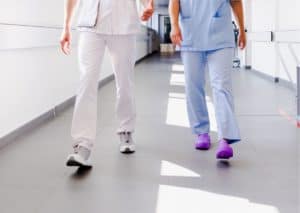An explanation of slip-resistance
Slips, Trips and Falls – Slip Resistance Explained
According to the Health and Safety Executive (HSE), there were 111,000 self-reported non-fatal injuries to workers caused by slips, trips and falls on level ground in the UK in 2017. (Source: HSE Report ‘Kinds of accident in Great Britain 2017′)
A major piece of occupational health and safety legislation in the UK is the Health and Safety at Work etc Act 1974 (also known as HSWA, HSW Act and HASAWA). According to the Act, employers are responsible for protecting their employees’ health, safety, and welfare. This also applies to other people who might be affected by their business. It is the employer’s responsibility to take all reasonable steps to achieve this. This includes taking steps to control slips and trips.
Controlling slips and trips goes beyond ensuring walkways are free of hazards. It is also very important to wear the right kind of footwear in the workplace. In non-safety shoes with little or no tread, it is possible to slip on a variety of surfaces, increasing the likelihood of an accident or incident.
Slip Resistance Ratings
You may have noticed slip-resistance ratings on your footwear. The following chart details the slip resistance ratings for industrial PPE footwear in Europe EN ISO 13287. This includes the testing conditions and the minimum requirements.
SRA rated slip-resistance footwear styles are tested on a ceramic tile surface with a sodium lauryl sulphate (SLS) solution.
SRB rated slip-resistance footwear styles are tested on a steel floor surface with a glycerol solution.
A slip-resistance style with an SRC rating is a combination of both an SRA and an SRB rating. Soles rated SRC were tested on ceramic tile surfaces with sodium lauryl sulfate (SLS) solutions and on steel floors with glycerol solutions.
For a rating to be awarded, it must meet the minimum coefficient requirements above.
What Does the Coefficient of Friction Mean?
Coefficients of friction represent the relationship between the force of friction between two objects and the normal reaction between them. A measurement of friction between two surfaces depends on how easily they move against one another.
A low coefficient of friction is generally associated with poor traction when smooth surfaces come into contact. Imagine soft socks on a freshly polished floor. Two rough surfaces with better traction typically have higher coefficients of friction. Much like wearing socks on a wool pile carpet.
Does Slip Resistance Work on all Surfaces?
When it comes to slippery conditions, slip-resistant shoes offer greater traction on a variety of surfaces. Where liquid such as oil has been spilt, the grip will always be better than that of shoes which don’t have an anti-slip sole. It is still advisable to exercise caution when dealing with liquids on any surface. There are still risks associated with extreme conditions, such as ice. During these conditions, you can fit traction-enhancing products over your shoes to gain traction on snow and ice.
Are All Anti-slip Shoes Equal?
No, there are many elements that vary between shoes, such as the sole material, the tread design, and the pattern. In spite of the fact that each shoe style is tested before receiving its slip-resistance rating, the coefficiency of adhesion scores can differ from one style to another. So you can get footwear rated with SRC that may have a better coefficient of friction score than another style rated with the same SRC.

Are All PLS Shoes Anti-slip?
Yes! A majority of our shoes are SRC-rated – the highest level possible. A small number of the products have SRA ratings, which are clearly marked. We do not sell any professional shoes without a slip-resistance rating.
For each style, we also provide product specification sheets that include coefficient friction test results. Additionally, product data sheets provide useful information on different aspects of testing, such as impact resistance.
Would you like to learn more about professional footwear before making a decision? Here are some blog articles you may find helpful:
What are Anti-static and ESD? Click here to read our ‘Antistatic and ESD Explained’ blog.
What are slip-resistance standards? Click here to read our ‘Safety and Occupational Footwear Explained’ blog.
Looking for student placement shoes? Click here to read our ‘Best Shoes for Student Nursing Placement’ blog.
Do you have Plantar Fasciitis or other common aches and pains? Click here to read our ‘The Best Shoes for Plantar Fasciitis’ blog.
Looking for washable footwear? Click here to read our ‘Washable Shoes and Clogs for Nurses’ blog.
Do you have sore or tired feet? Click here to read our ‘5 Top Tips for Happy Healthy Feet’ blog.
What are the best nursing shoes for you? Click here to read our ‘The Best Nursing Shoes’ blog.



